Jill-Jênn Vie
Researcher at Inria
% Using Ratings & Posters\newline for Anime & Manga Recommendations \vspace{-5mm}
% \vspace{-5mm}  {height=3.1cm}
{height=3.1cm}  {height=3.1cm}
{height=3.1cm}  {height=3.1cm}
{height=3.1cm}  {height=3.1cm} \alert{Jill-Jênn Vie}¹³ \and \quad Florian Yger² \and \quad Ryan Lahfa³ \and \quad Hisashi Kashima¹\textsuperscript4\newline \and Basile Clement³ \and Kévin Cocchi³ \and Thomas Chalumeau³
% ¹ RIKEN Center for Advanced Intelligence Project (Tokyo)\newline ² Université Paris-Dauphine (France)\newline ³ Mangaki (Paris, France)\newline \textsuperscript4 Kyoto University \hfill \includegraphics[width=2cm]{figures/mangakiwhite.png}
—
theme: metropolis
themeoptions:
- sectionpage=none
section-titles: false
header-includes:
- \usepackage{tikz}
- \usepackage{array}
- \usepackage{icomma}
- \usepackage{multicol,booktabs}
- \def\R{\mathcal{R}}
- \usecolortheme{owl}
—
{height=3.1cm} \alert{Jill-Jênn Vie}¹³ \and \quad Florian Yger² \and \quad Ryan Lahfa³ \and \quad Hisashi Kashima¹\textsuperscript4\newline \and Basile Clement³ \and Kévin Cocchi³ \and Thomas Chalumeau³
% ¹ RIKEN Center for Advanced Intelligence Project (Tokyo)\newline ² Université Paris-Dauphine (France)\newline ³ Mangaki (Paris, France)\newline \textsuperscript4 Kyoto University \hfill \includegraphics[width=2cm]{figures/mangakiwhite.png}
—
theme: metropolis
themeoptions:
- sectionpage=none
section-titles: false
header-includes:
- \usepackage{tikz}
- \usepackage{array}
- \usepackage{icomma}
- \usepackage{multicol,booktabs}
- \def\R{\mathcal{R}}
- \usecolortheme{owl}
—
Mangaki
Mangaki
RIKEN Center for Advanced Intelligence Project (AIP)
 \
\
- Public research institute ($\simeq$ Inria) near Tokyo Station
- Theoretical, applied & ethical AI research
- More GPUs than researchers
- 12 accepted papers at NeurIPS 2018, 13 at AAAI 2019, 14 at ICML 2019
Mangaki, recommendations of anime/manga
Rate anime/manga and receive recommendations

350,000 ratings by 2,000 users on 10,000 anime & manga
- myAnimeList
- AniDB
- AniList
- (soon) TVtropes
Build a profile
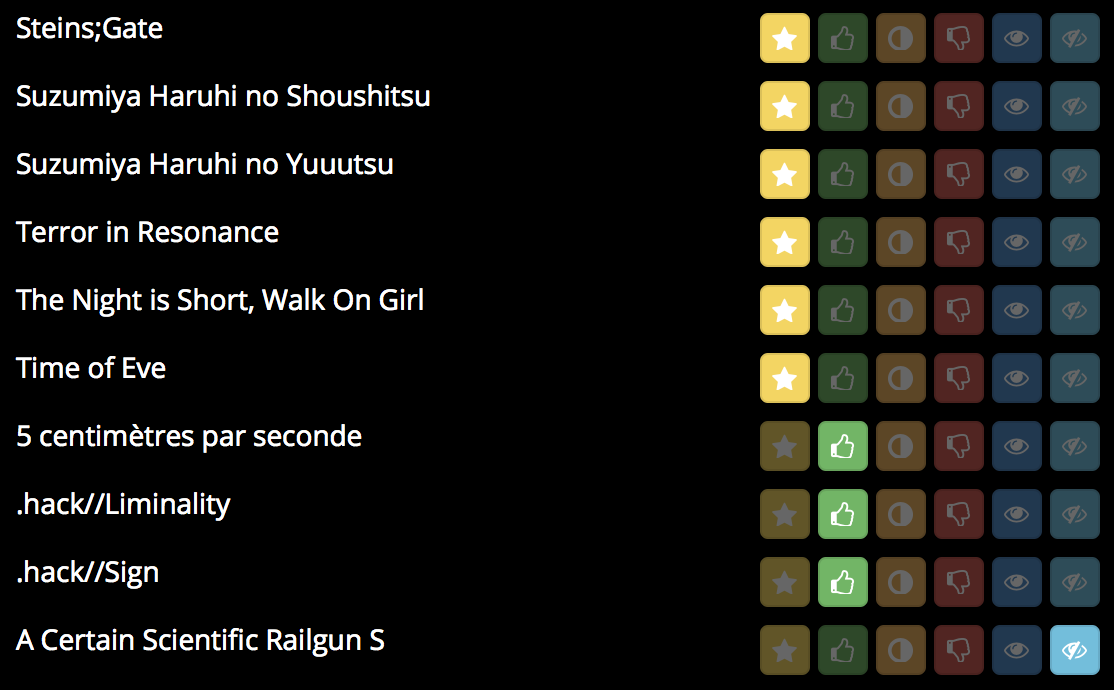
Mangaki prioritizes your watchlist

Browse the rankings: top works
>>> from mangaki.models import Work
>>> Work.objects.filter(category__slug='anime').top()[:8]

Why nonprofit?
- Why should blockbusters get all the fun/clicks/money?
- Maybe there is one precious, unknown anime \alert{for you}
- and we can help you find it
Driven by passion, not profit
- Everything is open source: \alert{github.com/mangaki}
- Python (Django), Vue.js
- Many Jupyter notebooks (check ‘em out!)
Awards: Microsoft Prize (2014) Japan Foundation (2016)
A simple idea: precious pearls
Work.objects.filter(category__slug='anime').pearls()[:8]

Outline
1. Usual algorithms for recommender systems
- Collaborative filtering (\alert{ALS})
- Content-based (\alert{LASSO})
2. Our method
- How to use posters
- Blending models
3. Experiments
- Dataset: Mangaki
- Results
Recommender Systems
Recommender Systems
Recommender Systems
Problem
- Every user rates few items (1 %)
- How to infer missing ratings?
Example
\begin{tabular}{ccccc}
& \includegraphics[height=2.5cm]{figures/1.jpg} & \includegraphics[height=2.5cm]{figures/2.jpg} & \includegraphics[height=2.5cm]{figures/3.jpg} & \includegraphics[height=2.5cm]{figures/4.jpg}
Sacha & ? & 5 & 2 & ?
Ondine & 4 & 1 & ? & 5
Pierre & 3 & 3 & 1 & 4
Joëlle & 5 & ? & 2 & ?
\end{tabular}
Recommender Systems
Problem
- Every user rates few items (1 %)
- How to infer missing ratings?
Example
\begin{tabular}{ccccc}
& \includegraphics[height=2.5cm]{figures/1.jpg} & \includegraphics[height=2.5cm]{figures/2.jpg} & \includegraphics[height=2.5cm]{figures/3.jpg} & \includegraphics[height=2.5cm]{figures/4.jpg}
Sacha & \alert{3} & 5 & 2 & \alert{2}
Ondine & 4 & 1 & \alert{4} & 5
Pierre & 3 & 3 & 1 & 4
Joëlle & 5 & \alert{2} & 2 & \alert{5}
\end{tabular}
What is a machine learning algorithm?
Fit
\begin{center}
\begin{tabular}{ccc} \toprule
Ondine & \alert{like} & \emph{Zootopia}
Ondine & \alert{favorite} & \emph{Porco Rosso}
Sacha & \alert{favorite} & \emph{Tokikake}
Sacha & \alert{dislike} & \emph{The Martian}\ \bottomrule
\end{tabular}
\end{center}
Predict
\begin{center}
\begin{tabular}{ccc} \toprule
Ondine & \alert{\only<1>{?}\only<2>{favorite}} & \emph{The Martian}
Sacha & \alert{\only<1>{?}\only<2>{like}} & \emph{Zootopia}\ \bottomrule
\end{tabular}
\end{center}
What is a \alert{bad} machine learning algorithm?
Fit
\begin{center}
\begin{tabular}{ccc} \toprule
Ondine & \alert{like} & \emph{Zootopia}
Ondine & \alert{favorite} & \emph{Porco Rosso}
Sacha & \alert{favorite} & \emph{Tokikake}
Sacha & \alert{dislike} & \emph{The Martian}\ \bottomrule
\end{tabular}
\end{center}
\hfill 100% correct
Predict
\begin{center}
\begin{tabular}{ccc} \toprule
Ondine & \alert{dislike} & \emph{The Martian} (was: favorite)
Sacha & \alert{neutral} & \emph{Zootopia} (was: like)\ \bottomrule
\end{tabular}
\end{center}
\hfill 20% correct
Cannot generalize
What is a \alert{good} machine learning algorithm?
Fit
\begin{center}
\begin{tabular}{ccc} \toprule
Ondine & \alert{favorite} & \emph{Zootopia} (was: like)
Ondine & \alert{favorite} & \emph{Porco Rosso}
Sacha & \alert{favorite} & \emph{Tokikake}
Sacha & \alert{dislike} & \emph{The Martian}\ \bottomrule
\end{tabular}
\end{center}
\hfill 90% correct
Predict
\begin{center}
\begin{tabular}{ccc} \toprule
Ondine & \alert{like} & \emph{The Martian} (was: favorite)
Sacha & \alert{favorite} & \emph{Zootopia} (was: like)\ \bottomrule
\end{tabular}
\end{center}
\hfill 90% correct
Usual techniques
- Collaborative filtering
-
\hfill (solely based on ratings)
- $K$-nearest neighbors
- Matrix factorization:
- Alternating least squares (\alert{ALS})
- Content-based
-
\hfill (work features: directors, genre, etc.)
- Sparse linear regression (\alert{LASSO})
- Hybrid recommender systems
-
\hfill (combine those two)
- The proposed method
Example: $K$-Nearest Neighbors
Does Emmanuel like Paprika?
\includegraphics{figures/ratings1black.jpg}
Example: $K$-Nearest Neighbors
Who are Emmanuel’s 2 nearest neighbors?
\includegraphics{figures/knnblack.jpg}
>>> from mangaki.algo.knn import MangakiKNN
>>> knn = MangakiKNN()
>>> knn.get_neighbors([EMMANUEL_ID])
[JUSTIN_ID, ANGELA_ID]
Example: $K$-Nearest Neighbors
>>> knn.predict([EMMANUEL_ID, PAPRIKA_ID])
\includegraphics{figures/ratings2black.jpg}
How to compare algorithms?
\centering
\begin{tabular}{cccccc}
dislike & wontsee & neutral & willsee & like & favorite
-2 & -0.5 & 0.1 & 0.5 & 2 & 4
\end{tabular}
\raggedright
Penalty
- If I predict:
-
\alert{favorite} for favorite $\rightarrow$ 0 error
\alert{dislike} for favorite $\rightarrow$ $(4 - (-2))^2 = 36$ error
\alert{like} for favorite $\rightarrow$ 4 error
Error: Mean value of (difference)²
RMSE: square root of that
\alert<2>{Divide} / \alert<3,5>{Fit} / \alert<4,6>{Predict}
\begin{tabular}{c|c|c|c|c}
A likes 1 & & C likes 1 & & E \alert<3-4>{\only<3>{?}\only<1-2,4-6>{neutral}} 3
B likes 2 & B dislikes 3 & C likes 2 & D \alert<5-6>{\only<5>{?}\only<1-4,6>{wontsee}} 3 & C \alert<3-4>{\only<3>{?}\only<1-2,4-6>{willsee}} 2
& B likes 4 & & D \alert<5-6>{\only<5>{?}\only<1-4,6>{wontsee}} 4
\end{tabular}
Matrix factorization $\rightarrow$ reduce dimension to generalize
Idea: Do \alert{user2vec} for all users, \alert{item2vec} for all movies
such that users like movies that are in their direction.
Fit
- $R$ ratings, \alert{$U$} user vectors, \alert{$W$} work vectors.
\pause
Predict: Will user $i$ like item $j$?
- Just compute $\alert{U_i} \cdot \alert{W_j}$ and you will find out!
Algorithm \alert{ALS}: Alternating Least Squares (Zhou, 2008)
- Until convergence (~ 20 iterations):
- Fix $U$ (users) learn $W$ (works)
\hfill in order to minimize the error (+ something) - Fix $W$ find $U$
- Fix $U$ (users) learn $W$ (works)
Illustration of ALS
\only<1>{\includegraphics{figures/embed0.pdf}} \only<2>{\includegraphics{figures/embed1.pdf}} \only<3>{\includegraphics{figures/embed2.pdf}} \only<4>{\includegraphics{figures/embed3.pdf}} \only<5>{\includegraphics{figures/embed4.pdf}} \only<6>{\includegraphics{figures/embed5.pdf}} \only<7>{\includegraphics{figures/embed6.pdf}} \only<8>{\includegraphics{figures/embed7.pdf}} \only<9>{\includegraphics{figures/embed8.pdf}} \only<10>{\includegraphics{figures/embed9.pdf}} \only<11>{\includegraphics{figures/embed10.pdf}} \only<12>{\includegraphics{figures/embed11.pdf}} \only<13>{\includegraphics{figures/embed12.pdf}} \only<14>{\includegraphics{figures/embed13.pdf}} \only<15>{\includegraphics{figures/embed14.pdf}} \only<16>{\includegraphics{figures/embed15.pdf}} \only<17>{\includegraphics{figures/embed16.pdf}} \only<18>{\includegraphics{figures/embed17.pdf}} \only<19>{\includegraphics{figures/embed18.pdf}} \only<20>{\includegraphics{figures/embed19.pdf}} \only<21>{\includegraphics{figures/embed20.pdf}} \only<22>{\includegraphics{figures/embed21.pdf}} \only<23>{\includegraphics{figures/embed22.pdf}} \only<24>{\includegraphics{figures/embed23.pdf}} \only<25>{\includegraphics{figures/embed24.pdf}} \only<26>{\includegraphics{figures/embed25.pdf}} \only<27>{\includegraphics{figures/embed26.pdf}} \only<28>{\includegraphics{figures/embed27.pdf}} \only<29>{\includegraphics{figures/embed28.pdf}} \only<30>{\includegraphics{figures/embed29.pdf}} \only<31>{\includegraphics{figures/embed30.pdf}} \only<32>{\includegraphics{figures/embed31.pdf}} \only<33>{\includegraphics{figures/embed32.pdf}} \only<34>{\includegraphics{figures/embed33.pdf}} \only<35>{\includegraphics{figures/embed34.pdf}} \only<36>{\includegraphics{figures/embed35.pdf}} \only<37>{\includegraphics{figures/embed36.pdf}} \only<38>{\includegraphics{figures/embed37.pdf}} \only<39>{\includegraphics{figures/embed38.pdf}}
Why \alert{+ something}? Regularize to generalize
\begin{columns}
\begin{column}{0.6\linewidth}
Just minimize RMSE
May not be optimal\\vspace{2cm}
Minimize RMSE + regularization:
$\Rightarrow$ easier to optimize
\end{column}
\begin{column}{0.4\linewidth}
\hfill \includegraphics[width=\linewidth]{figures/nonreg.pdf}
\hfill \includegraphics[width=\linewidth]{figures/reg.pdf}
\end{column}
\end{columns}
Visualizing all anime
\alert{Closer} points mean similar taste
\vspace{-1cm}
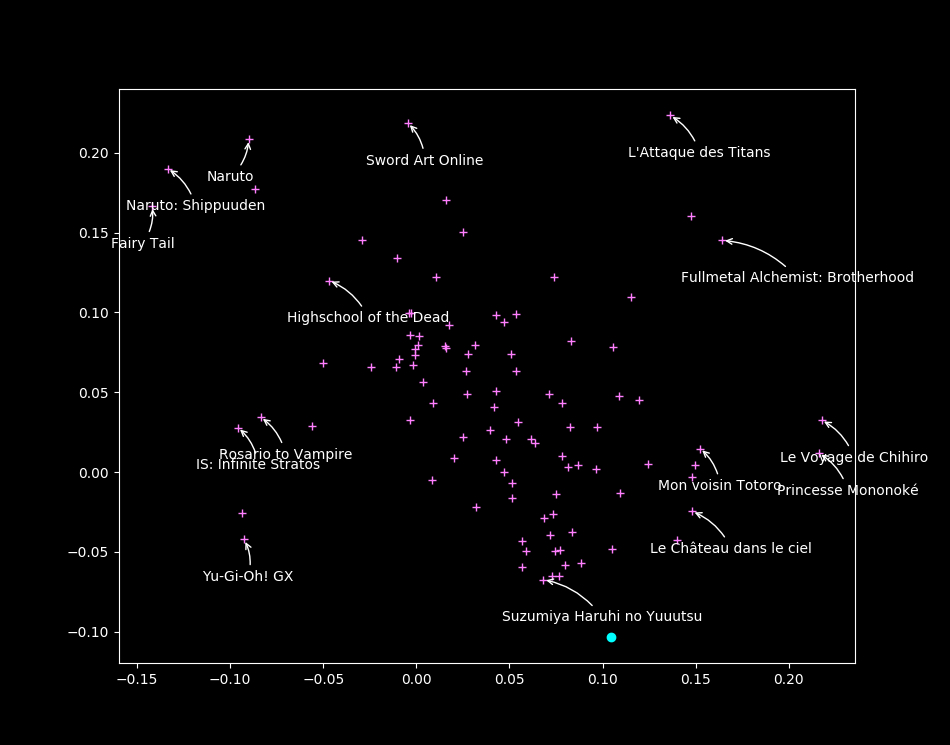 \
\
Find your taste by plotting your vector
You will \alert{like} anime that are \alert{in your direction}
\vspace{-1cm}
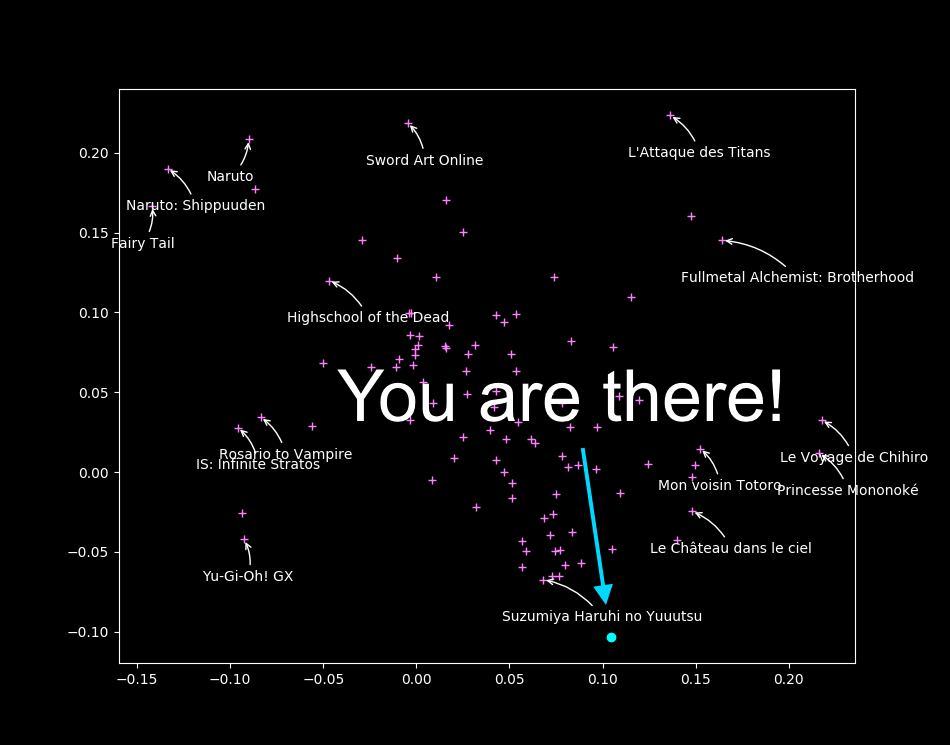 \
\
Drawback with collaborative filtering
Issue: Item Cold-Start
- If no ratings are available for a work $j$
$\Rightarrow$ Its vector $W_j$ cannot be learned :-(
No way to distinguish between unrated works.
But we have (many) posters!

Our method
Our method
Illustration2Vec (Saito and Matsui, 2015)
\centering
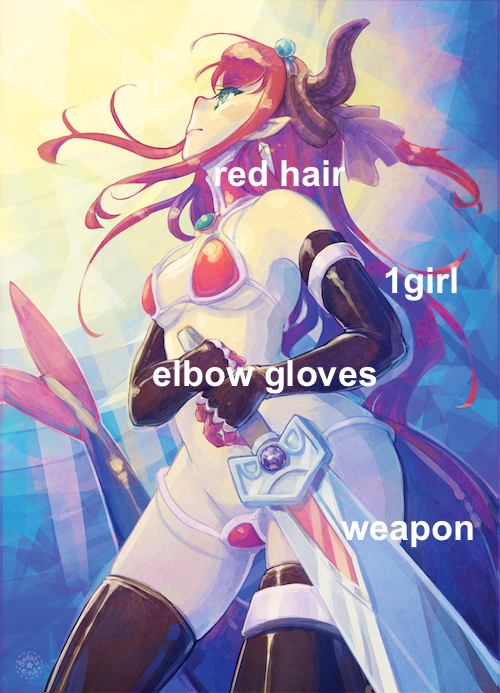 {height=70%}\
{height=70%}\
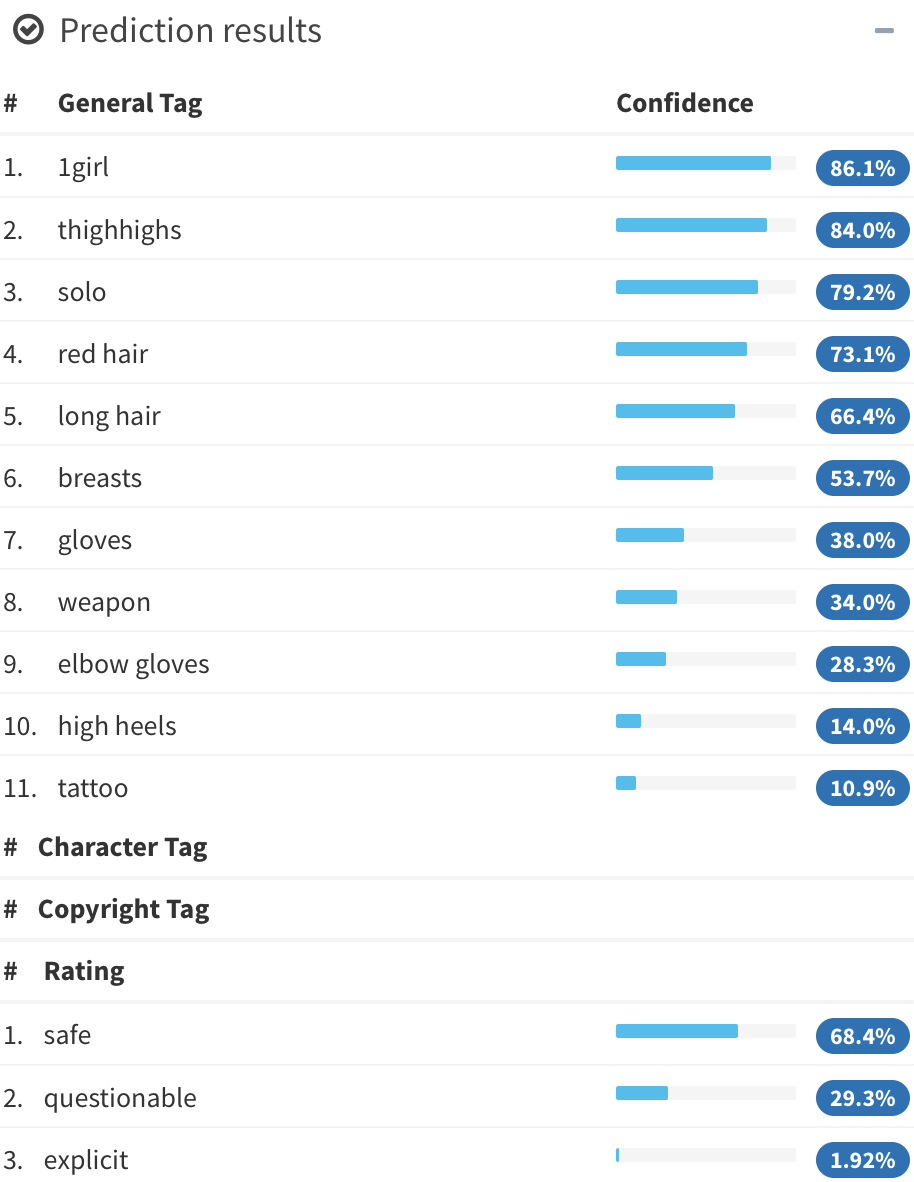 {height=70%}\
{height=70%}\
- CNN (VGG-16) pretrained on ImageNet (photos)
- Retrained on Danbooru (1.5M manga illustrations with tags)
- 502 most frequent tags kept, outputs \alert{tag weights}
LASSO for sparse linear regression
$T$ matrix of 15000 works $\times$ 502 tags ($T_j$: tags of work $j$)
Fit
- Each user is described by its preferences over tags \alert{$P_i$}
- \alert{LASSO constraint}: user likes/hates few tags
- Learn user preferences \alert{$P_i$} such that \(\hat{r}_{ij}^{LASSO} = \alert{P_i} \cdot T_j.\)
\pause
Predict: Will user $i$ like work $j$?
- Here is a new work with a poster and tags $T_j$
- Just compute $\alert{P_i} \cdot T_j$ and you will find out!
Interpretation and explanation of user preferences
- You seem to like \alert{\emph{magical girls}} but not \alert{\emph{blonde hair}}
$\Rightarrow$ Look! All of them are \alert{\emph{brown hair}}! Buy now!
Combine models
Which model should we choose between ALS and LASSO?
- Answer
-
Both!
- Methods
-
boosting, bagging, model stacking, blending.
- Idea
-
find $\alert<2>{\alpha\only<2>{j}}$ s.t. $\hat{r{ij}} \triangleq \alert<2>{\alpha\only<2>{j}} \hat{r}{ij}^{ALS} + (1 - \alert<2>{\alpha\only<2>{j}}) \hat{r}{ij}^{LASSO}.$
If popular, listen to ALS more than LASSO
Our Architecture
\includegraphics{figures/archiwhite-rv.pdf}
Examples of $\alpha_j$
\centering \includegraphics{figures/curve1-rv.pdf}
Mimics ALS \(\hat{r_{ij}} \triangleq \alert1 \hat{r}_{ij}^{ALS} + \alert0 \hat{r}_{ij}^{LASSO}.\)
Examples of $\alpha_j$
\centering \includegraphics{figures/curve2-rv.pdf}
Mimics LASSO \(\hat{r_{ij}} \triangleq \alert0 \hat{r}_{ij}^{ALS} + \alert1 \hat{r}_{ij}^{LASSO}.\)
Examples of $\alpha_j$
\centering \includegraphics{figures/curve3-rv.pdf} \(\hat{r}_{ij}^{BALSE} = \begin{cases} \hat{r}_{ij}^{ALS} & \text{if item $j$ was rated at least $\gamma$ times}\\ \hat{r}_{ij}^{LASSO} & \text{otherwise} \end{cases}\) But we can’t: \alert{Not differentiable!}
Examples of $\alpha_j$
\centering \includegraphics{figures/curve4-rv.pdf} \(\hat{r}_{ij}^{BALSE} = \alert{\sigma(\beta(R_j - \gamma))} \hat{r}_{ij}^{ALS} + \left(1 - \alert{\sigma(\beta(R_j - \gamma))}\right) \hat{r}_{ij}^{LASSO}\) $\beta$ and $\gamma$ are learned by stochastic gradient descent.
Blended Alternate Least Squares with Explanation
\centering
Blended Alternate Least Squares with Explanation
Blended Alternate Least Squares with Explanation
Blended Alternate Least Squares with Explanation
Blended Alternate Least Squares with Explanation
Blended Alternate Least Squares with Explanation
Blended Alternate Least Squares with Explanation \only<2>{(\alert{BALSE})}
Experiments
Experiments
Comparing algorithms: cross-validation
- 80% of the ratings are used for training
- 20% of the ratings are kept for testing
Differents sets of items:
- Whole test set of works
- 1000 works least rated (1.5%)
- Cold-start: works not seen in the training set (only the posters)
Results
\centering
\
Summing up
We presented BALSE, a model that:
- uses information in the \alert{ratings} (collaborative filtering)
- uses information in the \alert{posters} using CNNs (content-based)
- combine them in a \alert{nonlinear} way
to \alert{improve} the recommendations, and \alert{explain} them.
Future work: Make your neural network watch the anime
Extract frames from episodes

\hfill \emph{Cowboy Bebop EP 23} “Brain Scratch”, Sunrise
Coming soon: Watching assistant
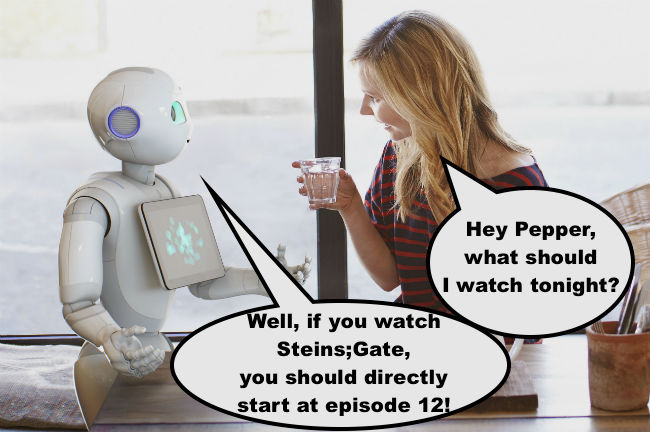
Thank you! \hfill jj@mangaki.fr
\centering
 {width=45%}\
{width=45%}\
Try it: \alert{mangaki.fr} \hfill Twitter: \alert{@MangakiFR}
\raggedright
\pause
Read the article
- Using Posters to Recommend Anime and Mangas in a Cold-Start Scenario: \alert{github.com/mangaki/balse} (front HN!)
\normalsize \pause
Know more
- AI for Manga & Anime: \alert{research.mangaki.fr}
\centering \includegraphics[height=3cm]{figures/styletransfer.jpg}